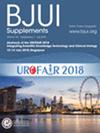Quantification of prostate cancer Gleason pattern 4 to predict oncological outcome.
IF 4.4
2区 医学
Q1 UROLOGY & NEPHROLOGY
引用次数: 0
Abstract
OBJECTIVES To determine if quantifying Gleason pattern 4 (GP4) is superior to Grade Group (GG) in predicting any and distant metastatic recurrence after radical prostatectomy (RP) for prostate cancer, and compare various GP4 quantification methods for predicting metastatic recurrence using preoperative targeted biopsy and magnetic resonance imaging (MRI) data. PATIENTS AND METHODS We conducted a retrospective study of patients who underwent MRI-guided biopsies and RP from 2009 to 2018. Patients with GG 2-4 without GP5 disease on biopsy and/or RP specimen were included. The predictors compared were biopsy GG, percentage of GP4 in biopsy cores, millimetres of GP4 in biopsy cores, and volume of GP4 based on MRI lesion volume. These methods were also compared to the Cancer of the Prostate Risk Assessment (CAPRA), International Staging Collaboration for Cancer of the Prostate (STAR-CAP), European Association of Urology (EAU), and National Comprehensive Cancer Network (NCCN) risk classifications. The C-index for each model was calculated to evaluate discrimination performance. RESULTS A total of 446 patients were analysed, with a median follow-up of 6.9 years for patients without an event; 46 patients developed any metastasis. For any metastatic recurrence based on biopsy findings, the CAPRA score (C-Index = 0.72) showed the highest discrimination among risk scores, surpassing biopsy GG (C-Index = 0.70), but was outperformed by percentage GP4 (C-Index = 0.74), millimetres GP4 (C-Index = 0.77), and volume of GP4 (C-Index = 0.80). CONCLUSION For patients with GG 2-4 prostate cancer containing GP4, preoperative GP4 volume estimation using MRI and targeted biopsy outperforms Gleason scoring classification and standard risk scores in predicting any and distant metastatic recurrence. Further research is warranted on the best methods to quantify GP4 before incorporation in treatment decision-making.量化前列腺癌Gleason模式4预测肿瘤预后。
目的探讨量化Gleason模式4 (GP4)在预测前列腺癌根治性前列腺切除术(RP)后任何转移性复发和远处转移性复发方面是否优于分级组(GG),并比较各种GP4量化方法在术前靶向活检和磁共振成像(MRI)数据预测转移性复发中的应用。患者和方法我们对2009年至2018年接受mri引导活检和RP的患者进行了回顾性研究。包括活检和/或RP标本中没有GP5疾病的GG -4患者。比较的预测因子是活检GG、活检芯中GP4的百分比、活检芯中GP4的毫米数以及基于MRI病变体积的GP4体积。这些方法还与前列腺癌风险评估(CAPRA)、国际前列腺癌分期合作(STAR-CAP)、欧洲泌尿外科协会(EAU)和国家综合癌症网络(NCCN)风险分类进行了比较。计算每个模型的c指数来评估识别性能。结果共分析了446例患者,无事件患者的中位随访时间为6.9年;46例患者出现任何转移。对于任何基于活检结果的转移性复发,CAPRA评分(C-Index = 0.72)在风险评分中表现出最高的区别,超过活检GG (C-Index = 0.70),但GP4百分比(C-Index = 0.74)、GP4毫米(C-Index = 0.77)和GP4体积(C-Index = 0.80)优于CAPRA评分。结论对于含有GP4的GG -4前列腺癌患者,术前使用MRI和靶向活检评估GP4体积在预测任何转移性复发和远处转移性复发方面优于Gleason评分分类和标准风险评分。在纳入治疗决策之前,需要进一步研究量化GP4的最佳方法。
本文章由计算机程序翻译,如有差异,请以英文原文为准。
求助全文
约1分钟内获得全文
求助全文
来源期刊

BJU International
医学-泌尿学与肾脏学
CiteScore
9.10
自引率
4.40%
发文量
262
审稿时长
1 months
期刊介绍:
BJUI is one of the most highly respected medical journals in the world, with a truly international range of published papers and appeal. Every issue gives invaluable practical information in the form of original articles, reviews, comments, surgical education articles, and translational science articles in the field of urology. BJUI employs topical sections, and is in full colour, making it easier to browse or search for something specific.
 求助内容:
求助内容: 应助结果提醒方式:
应助结果提醒方式:


